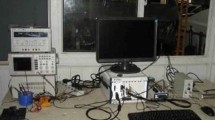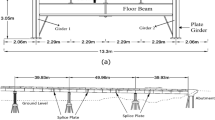Abstract
A finite element of the bridge was established to realize the virtual reality. Vehicle and wind loads were applied on it, and modal computation was carried out. Results show that serious vibration mainly took place on the bridge deck. Stresses and strains of the bridge were further extracted, where the maximum stress appeared around the positions with load application, while the maximum strain appeared in the middle of the bridge deck. Vibration response of the bridge under different excitations including vehicle loads and wind loads was computed by using the finite element model. Finally, neural network was also used to compute the vibration characteristic of the bridge, and the computational result was compared with that of the finite element method. The comparison result showed that they were consistent with each other, and the prediction model of neural networks was reliable. Using neural networks can improve the computational efficiency.













Similar content being viewed by others
References
Tao XY, Liu XG, Zhang YL (2010) Study on the stress characteristics of orthotropic steel deck. Steel Constr 25(7):12–14
Lee SB (1996) Fatigue failure of welded vertical members of a steel truss bridge. Eng Fail Anal 3(2):103–108
Wong KY (2003) Structural identification of Tsing Ma bridge. Trans Hong Kong Inst Eng 10(1):38–47
Li ZX, Zhou TQ, Chan THT et al (2007) Multi-scale numerical analysis on dynamic response and local damage in long-span bridge. Eng Struct 29(7):1507–1524
Lv Z, Halawani A, Feng S et al (2014) Multimodal hand and foot gesture interaction for handheld devices. ACM Trans Multimed Comput Commun Appl (TOMM) 11(1s):10
Wei W, Xu Q, Wang L et al (2014) GI/Geom/1 queue based on communication model for mesh networks. Int J Commun Syst 27(11):3013–3029
Lv Z, Tek A, Da Silva F et al (2013) Game on, science-how video game technology may help biologists tackle visualization challenges. PLoS ONE 8(3):e57990
Maekawa K, Ishida T, Kishi T (2003) Multi-scale modeling of concrete performance integrated material and structural mechanics. J Adv Concr Technol 1:91–126
Wei W, Qiang Y, Zhang J (2013) A bijection between lattice-valued filters and lattice-valued congruences in residuated lattices. Math Probl Eng 36(8):4218–4229
Wong KW, Lin Q, Chen J (2011) Error detection in arithmetic coding with artificial markers. Comput Math Appl 62(1):359–366
Chen J, Lin Q, Shen LL (2011) An immune-inspired evolution strategy for constrained optimization problems. Int J Artif Intell Tools 20(03):549–561
Au FTK, Cheng YS, Cheung YK (2001) Effects of random road surface roughness and long-term deflection of prestressed concrete girder and cable-stayed bridges on impact due to moving vehicles. Comput Struct 79(8):853–872
Yang YB, Jsay JY (2008) Wind-induced aerostatic instability of cable-supported bridges by a two-stage geometric nonlinear analysis. Interact Multiscale Mech 1(3):381–396
Wang GC (2008) Nonlinear analysis of vehicle-bridge coupled vibration of railway cable-stayed bridges with long span. Chin J Appl Mech 25(3):524–528
Li YL, Qiang SZ (2005) Dynamics of wind-rail vehicle-bridge systems. J Wind Eng Ind Aerodyn 93(6):483–507
Chen M, Ge SS, How BVE (2010) Robust adaptive neural network control for a class of uncertain MIMO nonlinear systems with input nonlinearities. IEEE Trans Neural Networks 21(5):796–812
Magnier L, Haghighat F (2010) Multiobjective optimization of building design using TRNSYS simulations, genetic algorithm, and artificial neural network. Build Environ 45(3):739–746
Lv Z, Halawani A, Feng S et al (2015) Touch-less interactive augmented reality game on vision-based wearable device. Pers Ubiquit Comput 19(3–4):551–567
Ruan JH, Shi Y (2016) Monitoring and assessing fruit freshness in IOT-based e-commerce delivery using scenario analysis and interval number approaches. Inf Sci 373(10):557–570
Author information
Authors and Affiliations
Corresponding author
Ethics declarations
Conflict of interest
We have confirmed that this article was not submitted or published in the other journals, and it was only submitted to Neural Computing and Applications. There is no conflict of interest.
Rights and permissions
About this article
Cite this article
Dong, Fh. Virtual reality research on vibration characteristics of long-span bridges with considering vehicle and wind loads based on neural networks and finite element method. Neural Comput & Applic 29, 1303–1309 (2018). https://doi.org/10.1007/s00521-017-2861-7
Received:
Accepted:
Published:
Issue Date:
DOI: https://doi.org/10.1007/s00521-017-2861-7




